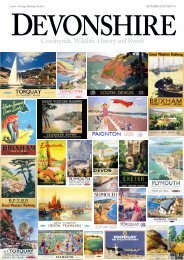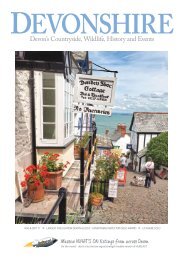Devonshire's East Devon magazine September October 2018
Create successful ePaper yourself
Turn your PDF publications into a flip-book with our unique Google optimized e-Paper software.
AA Box 456<br />
by Ian Hosker<br />
Box 456 stands almost half<br />
AA hidden in a layby that is<br />
shrinking annually as the hedgerow<br />
creeps ever closer to the A3052,<br />
Lyme Regis to Exeter road in <strong>Devon</strong>.<br />
It is very easy to miss as you drive<br />
westwards towards Exeter, near<br />
Newton Poppleford, where the road<br />
climbs and gently curves towards<br />
the left as it approaches a hazardous<br />
junction. The driver’s attention will<br />
most likely be focused on the safely<br />
navigating the junction. If you are a<br />
passenger, then turn your head to<br />
the left as the car climbs towards<br />
the Halfway House restaurant, and<br />
you will see what must be one of the<br />
smallest ‘Listed’ buildings in England.<br />
The first of these iconic kiosks were<br />
built in 1912, initially as shelters for AA<br />
patrols, and by 1920, there were 61<br />
kiosks fitted with telephones. Every<br />
AA member had a key to gain entry,<br />
giving access to the telephone. This<br />
allowed members to make local<br />
calls free of charge, presumably, but<br />
perhaps not exclusively, to call for<br />
help. There was also a first aid kit and<br />
a small supply of petrol (health and<br />
safety was not invented then).<br />
By 1962, there were almost 1000<br />
boxes (kiosks) across the UK, but<br />
the exponential growth in car<br />
ownership, and the expansion of<br />
the motorway network saw the end<br />
of traditional boxes being built in<br />
favour of telephone posts. These<br />
were much cheaper and so could be<br />
more numerous across an expanding<br />
road network. By the late 1960’s the<br />
traditional wooden kiosks were being<br />
phased out and decommissioned.<br />
All the remaining working AA kiosks<br />
were decommissioned in 2002<br />
because the rise of the mobile phone<br />
made them redundant.<br />
There are now only 19 traditional<br />
AA telephone kiosks in existence<br />
(although none are functioning<br />
as telephone boxes), and eight of<br />
them have a Grade II heritage listing<br />
because of their iconic status and<br />
historic value. In granting heritage<br />
listing status, the Secretary of<br />
State for Culture, Media and Sport<br />
considers two key criteria:<br />
• Architectural interest; or, as in the<br />
case of AA Box 456;<br />
• Historic Interest. To be of special<br />
historic interest a building must<br />
illustrate important aspects of<br />
the nation’s social, economic,<br />
cultural, or military history and/or<br />
have close historical associations<br />
with nationally important people.<br />
There should normally be some<br />
quality of interest in the physical<br />
fabric of the building itself to<br />
justify the statutory protection<br />
afforded by listing.<br />
AA Box 456 (and the other seven)<br />
stand as icons of a bygone era in<br />
motoring history when men (and<br />
they were men) in their ochre<br />
coloured uniforms and peaked caps<br />
saluted members as they passed by.<br />
Formed in 1905 when there were<br />
severe restrictions imposed upon<br />
motorists, especially regarding speed,<br />
the AA began life as patrols to warn<br />
motorists of nearby police patrols,<br />
and to offer any assistance they could.<br />
Of course, we now have our Garmin<br />
and TomTom satnavs with safety<br />
camera warnings, and we may have<br />
mixed feelings about that. How times<br />
have changed: or perhaps not.<br />
hubcast<br />
.co.u k<br />
What’s on in <strong>Devon</strong><br />
13

















